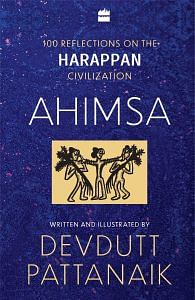Many cultures around the world, including the Harappans, noticed that the Big Dipper constellation of seven stars (shaped like a giant spoon) rotates in the northern sky. Its orientation marks the different seasons. When its position over spring, summer, autumn and winter is marked, it creates the hooked cross: a symbol of celestial and seasonal rhythms, marking the times to sow seeds, harvest crops, and migrate with animals or anticipate floods or rains.
This hooked cross is known as swastika in Vedic traditions, for the phrase ‘su-asti’ means to let good things happen. This symbol is found in Harappan seals. This indicates they were aware of the north, and the movement of the Big Dipper over the seasons. In Vedic texts, the Big Dipper is called ‘SaptaRishi mandala’ and is linked to the seven sages. We do not know if the word ‘swastika’ or the concept of seven sages existed in Harappan times. But the symbol certainly existed. What it meant then we can only speculate. Directions were certainly important to Harappans as we see their streets were aligned to the cardinal directions.
Seven sages seven sisters
Tree worship and animal sacrifice is part of many desi (folk) and margi (mainstream) rituals in India. Harappan seals depict this as well. In one famous seal, a markhor is being offered in sacrifice by a devotee wearing a horned helmet to a deity standing between trees—also wearing a horned helmet. There is also an image of seven people dancing. They all have plumage on their heads, a pigtail or hanging hood behind the head, bangles around their arms, and are wearing skirts. Are these seven men or women? If women, they could represent the seven stars of the Pleiades constellation (Krittika nakshatra) that marked the eastern sky during the Harappan spring. If men, they could be the seven stars of the Big Dipper constellation (Sapta-rishi mandala) that can be seen rotating around the north to this day.
In Vedic literature, the seven sages had seven wives. The sages accused the wives of infidelity and so the wives moved away from the northern sky towards the eastern horizon, to reside with constellation Taurus, the bull (Rishabha rashi). From 4000 to 2000 bc, the sun was in the house of Taurus during the spring equinox, a memory that resurfaces in Shatapatha Brahmana (800 ad). After 2000 bc, it moved towards the house of Aries. Currently it is in the house of Pisces. The shift happens gradually over 2,150 years. Does this Harappan artwork indicate a spring equinox festival?
Starry sky
The idea of dividing the sky into twenty seven (3x3x3) divisions (nakshatra) is found in the Vedas but not in the Avesta. This was clearly a Harappan memory. The months of the Hindu calendar are named after star clusters near which the full moon occurred when the calendar was being formulated. As per astronomers, the moon was closest to these nakshatra around 3000 bc. This indicates that the Harappans introduced the immigrant Aryans to the nakshatra system of dividing the sky.
Harappans were also drawn to the sky, which is why their cities were laid as a grid, with streets running along the cardinal directions. Alignment with stars seems to be the only explanation for the streets in cities like Kalibangan not being parallel to walls, or for the strange oblique cuts in the rectangular rock-cut wells of Dholavira. On pottery we do see stars. This includes images of peacocks flying towards the stars, carrying humans in their bellies, and stars in the body of fish. Some scholars argue that the word for star and the word for fish was the same in the Harappan language, as it is in modern Dravidian language—min. So fish symbols in Harappan script refer to stars and constellations.
 This excerpt from Devdutt Pattanaik’s ‘Ahimsa’ has been published with the permission of HarperCollins India.
This excerpt from Devdutt Pattanaik’s ‘Ahimsa’ has been published with the permission of HarperCollins India.






